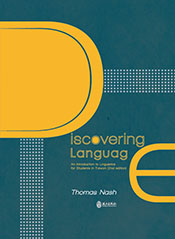 |
||||||||||||||||||||||||||
|
|
||||||||||||||||||||||||||
Discovering Language is designed for an introductory linguistics course at college and university level in Taiwan. The book aims to challenge students and stimulate their interest in the nature of language and how it fits into their lives, opening their eyes to their own beliefs about language. It is shorter and easier to read than most linguistics textbooks, with much more content related directly to the lives of students in Taiwan, such as examples from Mandarin, Taiwanese and an indigenous Austronesian language. Review questions allow students to check on their learning, while classroom-tested activities give them opportunities to apply and consolidate what they have studied. Material for small-group projects in which students observe some aspect of language directly is also included.
Thomas Nash
Thomas Nash taught in the Department of English Language and Literature, Fu Jen Catholic University, from 1983 to 2009. He served as department head from 1993 to 1999 and taught introductory linguistics as well as a range of courses in applied linguistics and English. He has degrees in anthropology and language teaching and learning from Humboldt State, California, and the University of Hawaii-Manoa. He now works as an editor and translator.
Chapter 1 – What Are We Talking About?
PROPERTIES OF LANGUAGE Displacement A Series of Levels Productivity Conventionality Discreteness and Contrasts Social Behavior and Cultural Transmission Change Gesture WHAT ARE WE GOING TO STUDY? PRACTICAL USES OF LINGUISTICS THE PRESENTATION OF LINGUISTIC EXAMPLES SUMMARY: What Are We Talking About? ACTIVITIES Chapter 2 – Psycholinguistics FOUR PRESSURES ON LANGUAGE Be Clear Be Processible Be Quick and Easy Be Expressive UNIVERSAL OPERATING PRINCIPLES A. Pay attention to the ends of words B. There are elements of language, grammatical markers, which show the relations between words C. Avoid exceptions D. Basic elements of meaning should be marked openly and clearly E. The use of grammatical markers should make sense GRAMMAR GROWS COMPREHENSION OF SPEECH SPEECH PRODUCTION GESTURE SUMMARY: Psycholinguistics ACTIVITIES Chapter 3 – Sociolinguistics THE SOCIOLINGUISTIC VIEW MUTUAL INTELLIGIBILITY VARIETIES OF LANGUAGE LANGUAGE AND SOCIAL GENDER POLITENESS A Cross-cultural Comparison Compliments SUMMARY: Sociolinguistics ACTIVITIES Your Language(s) Chapter 4 – Phonetics and Phonology PHONETICS Consonants Vowels Syllables Suprasegmentals: Elements of Sound that Interact with Syllables and Longer Units PHONOLOGY Interaction between Phonology and Other Parts of Grammar SUMMARY: Phonetics and phonology ACTIVITIES Chapter 5 – Morphology BASIC CONCEPTS DERIVATIONAL MORPHOLOGY INFLECTIONAL MORPHOLOGY Inflections on Nouns Inflections on Verbs Agreement and Government Types of Inflectional Morphology Mapping INTERACTION BETWEEN MORPHOLOGY AND PHONOLOGY WORDS THAT GO TOGETHER: COLLOCATIONS SUMMARY: Morphology ACTIVITIES Chapter 6 – Syntax WORD CLASSES Nouns Verbs Adjectives Adverbs Adpositions PHRASES AND HEADS Head-initial and Head-final Languages Head-marking and Dependent-marking CLAUSES AND SENTENCES Other Ways of Creating Complex Sentences CONSTITUENTS SYNTACTIC RELATIONS SYNTACTIC PROCESSES The Passive The Causative Other Processes SUMMARY: Syntax ACTIVITIES Chapter 7 – Semantics, Pragmatics, and Discourse THOUGHT MAPPING MEANING ONTO LANGUAGE WORD MEANING Features FROM WORDS TO LONGER EXPRESSIONS Prototypes, Stereotypes, and Relational Meaning Reference and Sense PRAGMATICS AND DISCOURSE MARKEDNESS SUMMARY: Semantics, Pragmatics, & Discourse ACTIVITIES Chapter 8 – Language Change SOUND CHANGE MORPHOLOGICAL AND SYNTACTIC CHANGE WORD CHANGE HISTORICAL LINGUISTICS SUMMARY: Language Change ACTIVITIES Chapter 9 – Writing and Language TYPES OF WRITING SYSTEMS Morphosyllabary Syllabary Abjad Alphabet Abugida HangulHOW WRITING REPRESENTS LANGUAGE DIFFERENCES BETWEEN WRITING AND LANGUAGE AND SPEECH Writing Systems, Scripts, and Orthographies Rate of Change Physical Existence Features of Writing Unrelated to Speech Social Aspects Dependence on Technology SUMMARY: Writing and Language ACTIVITIES Review Questions on Each Chapter Project Descriptions References Index |
最新消息
|
|||||||||||||||||||||||||
|
地址:116011台北市文山區指南路二段64號(研創中心2樓350206室) 電話:02-82375669、02-82375671 政大出版社書法題字:唐翼明 教授 © 2008 Chengchi University Press. All rights reserved. |
Site by Onion. | |||||||||||||||||||||||||

 TOP
TOP